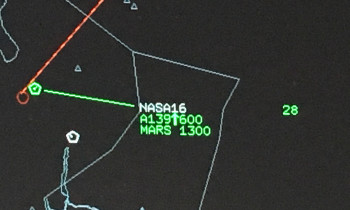Mission complete for air traffic controllers as NASA balloon launches
17 May 2016

The job of an air traffic controller traditionally consists of keeping aircraft separated in controlled airspace. But today was no ordinary day for Airways controller Shailendra Pandaram – when the ‘aircraft’ he saw on his radar screen was a massive 90-metre-diameter, 2.3 tonne balloon.
Today, Shailendra – known as Panda to his colleagues – had the job of guiding NASA’s high pressure scientific research balloon safely through the skies over Wanaka on the initial part of its journey to near space. Airways is New Zealand’s air navigation services provider and was responsible for managing the balloon – a similar size to Dunedin’s Forsyth Barr Stadium once fully inflated and at cruise altitude – through controlled airspace.
Prior to take-off, a launch window was determined that would avoid disruption to scheduled aircraft operations. Airways gave clearance for lift-off at 11.21am from its Christchurch-based radar centre, and the balloon lifted off the ground at 11.47am.
The balloon is carrying an automatic dependent surveillance – broadcast (ADS-B) radar transponder, which is the same technology used by larger commercial passenger aircraft.
“Once it was launched we were able to track it through our radar system, just as we would any other aircraft. At 13,500 feet, it entered controlled airspace and we made sure it stayed separated from other air traffic,” Panda says.
Separation standards outline the distance that must be maintained between aircraft in the sky. Specific separation standards have been designed by Airways for the launch of balloons.
“The balloon is slow moving and it has no pilot so there is more to consider when managing it through the airspace. Safety is our highest priority – for example, the payload of the balloon weighs over two tonnes so we ensured that all controlled airspace was clear below the balloon when it was climbing,” Panda says.
About 75 minutes after launch, at 60,000 feet, the balloon passed through controlled airspace and Airways’ role of separating the balloon from aircraft was complete. The organisation will continue to monitor the balloon while it is above New Zealand airspace.
Airways’ air traffic control systems will still be able to detect the balloon each time it passes over New Zealand during its planned 100-day trip around the earth, however it will be at near space altitude and won’t need to be managed by air traffic control.
Months of behind-the-scenes planning went into the launch and involved staff from a range of disciplines across Airways working closely with NASA.
“It has been a huge collaborative effort. To be part of something that involves NASA and is different from traditional air traffic control, gives it the buzz factor for everyone involved,” Panda says.
For more information please contact:
Emily Davies
Head of Public Affairs
Airways New Zealand
Mobile: 021 815 149
Email: communications@airways.co.nz
About Airways
Airways is a world-leading commercial Air Navigation Service Provider (ANSP), and operates in New Zealand as a State-Owned Enterprise (SOE). We look after key aviation infrastructure around New Zealand and manage the more than 1 million traffic movements per year into and around New Zealand’s 30 million sq km of airspace.
Airways provides air traffic control and engineering training, and has delivered air traffic management, Flightyield revenue management solutions, navigation services and consultancy in more than 65 countries.
For more information about Airways please visit www.airways.co.nz
About the NASA Balloon Program
The primary objective of the NASA Balloon Program is to provide high altitude scientific balloon platforms for scientific and technological investigations. These investigations include fundamental scientific discoveries that contribute to our understanding of the Earth, the solar system, and the universe. Scientific balloons also provide a platform for the
demonstration of promising new instrument and spacecraft technologies that enable or enhance the objectives for the Science Mission Directorate Strategic Plan.
For more information about NASA’s balloon program, visit the NASA Colombia Scientific Balloon Facility website here - http://www.csbf.nasa.gov/
